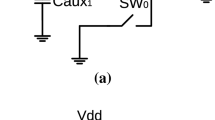Abstract
An analysis of the harmonic distortion in switched-current cells produced by the non-linear settling error is presented. Two approaches for computing the harmonic components are addressed: discrete-time Fourier series and power series expansion. They are based on the large signal behavior of the SI cell. A compact and flexible expression is obtained with series expansion. An alternative expression is presented for cases where only the settling error magnitude is required. The effect of charge redistribution between the input and the sampling nodes is analyzed. It is shown that including that effect, the harmonic distortion is increased, and the DC gain of the SI integrator is reduced. An analysis of the total harmonic distortion when clock-feed-through and non-linear settling error are both taken into account is presented. It is demonstrated that minimum distortion is reached for a given capacitive value. For a SI cell designed with 0.8 μm standard CMOS technology working at a sampling frequency of 8 MHz, a minimum THD of −72 dB can be obtained with a C gs ≈ 2.4 pF.
Similar content being viewed by others
References
1._ P.J. Crawley and G.W. Roberts, “Predicting harmonic distortion in switched-current memory circuits.” IEEE Transactions on Circuits and Systems—II: Analog and Digital Signal Processing, vol. 41, no. 2, pp. 73–86, 1994.
J.M. De la Rosa, B. Pérez-Verdú, F. Medeiro, R.D. R´ýo, and A. Rodríguez-Vázquez, “Effect of non-linear settling error on the harmonic distortion of fully-differential switched-current band-pass ΣΔ modulators.” IEEE International Symposium on Circuits and Systems, vol. I, pp. 340–343, 2001.
M. Helfenstein, “Analysis and design of switched-current networks.” Ph.D. thesis, Swiss Federal Institute of Technology, 1997.
M. Helfenstein and G.S. Moschytz, “Distortion analysis of switched-current circuits,” in Proc. IEEE International Symposium on Circuits and Systems. Montery, Calif., USA, 1998.
I. Jøgensen and G. Bogason, “Optimization and design of a low power switched current A/D-δσ-modulator for voice band applications.” Analog Integrated Circuits and Signal Processing, vol. 17, pp. 221–247, 1998.
D.G. Nairn, “Analytic step response of MOS current mirrors.” IEEE Transactions on Circuits and Systems—I: Fundamental Theory and Applications, vol. 40, no. 2, pp. 133–135, 1993.
C. Toumazou, J.B. Hughes, and N.C. Battersby, Switched-Currents an Analogue Technique for Digital Technology, IEE Circuits and Systems series 5. 1st edition. Peter Peregrinus Ltd. on behalf of the Institution of Electrical Engineers, London, U.K, 1993.
V. Dias, G. Palmisano, P. O'Leary, and F. Maloberti, “Fundamental limitations of switched-capacitors sigma-delta modulators.” IEE Proceedings-G, vol. 139, pp. 27–32, 1992.
J.G. Proakis and D.G. Manolakis, “Digital signal processing, principles, algorithms, and applications.” 3rd edition. Prentice Hall, New Jersey, USA, 1996.
J.M. Martins and V.F. Dias, “Harmonic distortion in switched-current audio memory cells.” IEEE Transactions on Circuits And Systems—–II: Analog and Digital Signal Processing, vol. 46, no. 3, pp. 326–334, 1999.
Author information
Authors and Affiliations
Rights and permissions
About this article
Cite this article
García-Andrade, M., Espinosa, G. & Báez-López, D. Harmonic Distortion in Switched Current Cells Due to Settling Error. Analog Integrated Circuits and Signal Processing 41, 199–208 (2004). https://doi.org/10.1023/B:ALOG.0000041636.60043.5e
Issue Date:
DOI: https://doi.org/10.1023/B:ALOG.0000041636.60043.5e




